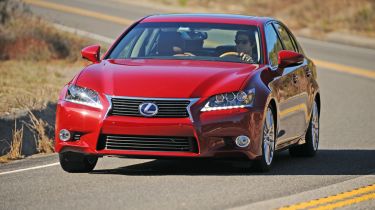Lexus GS 450h
New hybrid luxury car promises more thrills than before. Does the new GS deliver?

So has Lexus delivered on its promise to improve the way the GS looks and drives? Well, it stands out more, and inside there are big strides in terms of space and quality. On the road, however, it still doesn’t engage in the same way as a 5 Series. Instead, it continues to play the cards it always has – it’s well equipped and relaxing to drive. Priced at around £50,000, though, the flagship is unlikely to attract many new buyers. Lexus needs a new small hybrid version.
The latest GS marks the opening of a new chapter, says Lexus. From now on, Toyota’s luxury brand claims it will build cars that are exciting to look at and to drive, as well as being faultlessly reliable and brilliantly equipped.
The new GS gets a more stylish body and rear-wheel-drive chassis with lots of gadgets aimed at making it more fun. There is no diesel option as yet – the range kicks off with the petrol- engined GS 250 – but there’s talk of a more affordable small hybrid, as well as the flagship GS 450h driven here.
So could this be the car to worry Audi, BMW and Mercedes?
It gets off to a good start. The latest GS is more angular and sporty than before, and stands out next to rivals such as the Audi A6 and BMW 5 Series. The new grille gives the front end some much needed aggression and the LED daytime running lights look smart, too. Sadly, however, the rest of the shape is a little bland.
Used - available now

2025 Audi
Q5
14,820 milesAutomaticPetrol2.0L
Cash £33,387
2021 Kia
Soul EV
22,793 milesAutomaticElectric
Cash £15,700
2022 MG
HS
20,587 milesManualPetrol1.5L
Cash £15,187
2024 Kia
EV6
45,746 milesAutomaticElectric
Cash £23,700Inside, better packaging frees up more front and rear seat space. It has a 482-litre boot, too – a 60 per cent improvement over the old car, thanks to the more compact rear suspension – which has allowed the hybrid’s batteries to be repositioned.
The interior looks much more modern. The cabin is simpler, with a mix of wood, leather and metal. There are fewer switches, and neat touches such as a Maserati-style clock on the dash.
The gadget count on our range-topping car was sky high. It boasted a huge optional 12.3-inch central colour display with sat-nav, and a truly stunning 835-watt, 17-speaker Mark Levinson stereo. Safety equipment includes collision mitigation (which alerts the driver of approaching objects that may cause a crash), and lane-keep assist.
On the road, the GS 450h is every inch the luxurious limo, floating over bumps in almost total silence. With 338bhp on tap from the electric-assisted 3.5-litre V6, 0-62mph takes 5.9 seconds and in-gear response is strong. The electric motors and petrol engine combine to rocket the car up to motorway speeds and beyond. So it’s a shame that the six-speed CVT box hurts refinement.
At full throttle, the transmission maintains high revs as the CVT’s gear ratio rises, which makes the engine drone. At least it’s more economical than its predecessor, returning 47.8mpg (up from 36.7mpg). CO2 emissions have been slashed, too – dropping from 179g/km to only 137g/km.
Can the new GS give sporty executives such as the A6 and 5 Series competition on a twisty road? Thanks to wider tracks, with double-wishbone suspension at the front and a new multi-link rear set-up, the GS is more stable and composed.
There’s little in the way of body roll, and the steering has more weight than before. Thanks to adaptive dampers, the ride is generally very good, too. Choose an F Sport model and, as well as a bodykit and larger alloys, you can get Adaptive Variable Steering, which includes an optional rear-wheel steering system for extra agility.
The GS 450h still doesn’t engage the driver enough, though. Yes, you can put the car in Eco, Normal, Sport or Sport+ driving modes, which tweak throttle, suspension and steering response, but while the GS feels more agile in its racier settings, it doesn’t like being hustled. The steering never has much feel and the CVT gearbox is slow to respond.
But the new GS is definitely an improvement. Unfortunately, it’s not quite the big leap forward we were hoping for.







